
Guests
- Okwui EnwezorNigerian-born curator, art critic, writer, poet and educator, specializing in art history. He’s the director of the Haus der Kunst museum in Munich, Germany, and the first African director of the Venice Biennale.
As we broadcast from Venice, Italy, site of the Venice Biennale, the oldest and most prestigious international biennial art exhibition, we feature an extended interview with Okwui Enwezor of Nigeria, its first African-born chief curator. Enwezor has been widely credited for bringing political art back to the 120-year-old festival. He says he was partly inspired by the 1974 Venice Biennale when part of the exhibits were dedicated to Chile to protest the U.S.-backed coup that overthrew Chile’s democratic government. “Artists have a lot of meaning they produce that can allow us to look at the world in deeper, meaningful and more probing ways,” Enwezor says. As part of this year’s seven-month exhibit, there is an epic live reading of all three volumes of Karl Marx’s “Das Kapital.” Meanwhile, the artist Adam Pendleton incorporated the “Black Lives Matter” slogan into his exhibit which appears in the Belgium Pavilion. And the Brazilian artist Vik Muniz created a boat covered in the front page of a Venice newspaper published the day after nearly 400 migrants drowned off the Italian island of Lampedusa in October 2013.
Transcript
AMY GOODMAN: Well, we’re on the road in Venice, Italy, the site of the Venice Biennale, the oldest and most prestigious international biennial art exhibition in the world. The theme this year is “All the World’s Futures.” The exhibit is curated by Okwui Enwezor of Nigeria, who’s the first African-born curator of the 120-year-old festival. He has described “All the World’s Futures” as a, quote, “project devoted to a fresh appraisal of the relationship of art and artists to the current state of things.”
Enwezor has been widely credited for bringing political art back to the Venice Biennale. He has said he has been inspired by the 1974 biennial when part of the exhibits were dedicated to Chile to protest the U.S.-backed coup that overthrew Chile’s democratic government. As part of this year’s seven-month exhibit, there is an epic live reading of all three volumes of Karl Marx’s Das Kapital. Meanwhile, the artist Adam Pendleton incorporated the Black Lives Matter slogan into his exhibit, which appears in the Belgian Pavilion. And the Brazilian artist Vik Muniz created a boat covered in the front page of a Venice newspaper published the day after nearly 400 migrants drowned off the Italian island of Lampedusa in October of 2013.
This year’s Biennale has not been without controversy. In May, the city of Venice shut down Iceland’s pavilion in the Biennale after the artist Christoph Büchel, working in collaboration with the Muslim communities of Venice and Iceland, turned a 10th century church, that’s been closed down, into a working mosque. Police claimed the art project was a threat to public safety.
Well, we are joined by Okwui Enwezor right here in Venice. We’re speaking in the Arsenale. In addition to being the chief curator of the Venice Biennale, he’s director of the Haus der Kunst museum in Munich, Germany. He’s also an art critic, editor and writer.
Okwui Enwezor, it’s an honor to have you with us here, right behind the major theater where Creative Time, a New York-based art and activism organization, is holding its summit. Can you first place us—for people all over the world who are watching, what is the Venice Biennale, and where is it in Venice?
OKWUI ENWEZOR: Well, thank you so much, Amy, for having me on Democracy Now! It’s a great privilege to speak to you right at the epicenter of the Biennale, the Arsenale, which is a large complex of buildings dating back to the 10th century, in which many parts of this complex have been turned into exposition spaces for the Biennale. So, in a sense, the Biennale is not only situated within the historical fabric of commerce, of transnational trade and geopolitical changes, but it is also located, if you will, in this push and pull of the relationship between modernity and industrialization. So, it’s very apt that this year’s Biennale is very much engaged with all the histories that this very place embodies.
AMY GOODMAN: Talking about turning spears into plowshares, we’re sitting in the Arsenale, which was an old arsenal. I think it was the first industrial assembly line. They made warships here, a warship in a day. And yet today it serves a very different purpose.
OKWUI ENWEZOR: Well, you know, you made a reference to the fact that Christoph Büchel’s pavilion, for the Icelandic Pavilion, you know, it was located in a decommissioned Catholic church that had been closed down for over 40 years. And so, what you’re really witnessing in Venice is the way in which historical architecture, historical sites have also been similarly repurposed for the purposes of making contemporary art exhibitions. Because of the very vastness of these spaces and the vastness of contemporary art, these buildings are very much attractive for artists and the kind of scope and scale of work that they produce. And in a sense, the relationship between the exhibition and the residue of history that resides on this site is very important to explore. And we have tried to do so both in relation to what happens here in the Arsenale, this old industrial site, this old manufactory, if you will, as well as in the Central Pavilion located in the Giardini not too far from here.
AMY GOODMAN: So, let me ask you about art and activism, the complaint so often that art is removed from the world. Here we are in a very rarefied space in Venice, absolutely magnificent—the gondolas go by—although, of course, Venice is very threatened by climate change and the rising waters. I’ve just finished the headlines. As you heard, Ferguson, state of emergency. You just gave a speech today to hundreds of people, where you connected the issue of the Black Lives Matter movement, the issue of slavery and the issue of the relevance of art today. Why should people care about art when so much is happening, painful, in people’s everyday lives?
OKWUI ENWEZOR: Well, I mean, there are many reasons why people should care about art, first and foremost because artists have a lot of important things to say, a lot of important subjects to explore, and artists have a lot of meaning that they produce that can engage us to allow us to really look at, you know, the world in deeper, meaningful, but at the same time more probing, ways. So, I do feel that people should care about art, not only because of its—the fact that art necessarily changes the world, but I like to sort of to think about what I do and the way I work with artists as a position of learning and true engaging the substance of their thinking, their concepts and the material that come together to produce the kind of effect that art conveys.
So, art matters in many, many different ways, and I think it’s both in the large and small ways, that one can begin to see the utility of art not as something to be appropriated as propaganda or for ideological purposes, but the utility of art as a learning tool, as a teaching tool, but also as a way for the public to learn how to kind of expand their view of the world. And this Biennale, in particular, I have been immensely struck by the level and the deepness and the depth of engagement by artists really thinking about so many subject matter. You mentioned Adam Pendleton with Black Lives Matter. But if you go throughout the exhibition, what is very obvious is that the artist as an engaged subject, artists as people who interrogate the relationship between form and meaning, is, you know, more than something that’s essential, but also deeply engaging for the public at large.
AMY GOODMAN: I want to turn right now to the artist Adam Pendleton, who you just mentioned. He is the person who incorporated Black Lives Matter into the exhibit at the Belgian Pavilion here at the Venice Biennale. Adam Pendleton recently spoke to Artsy about the exhibit.
ADAM PENDLETON: One of the things that ended up becoming an important part of the project was the language that cropped up after the recent fatal shootings in the United States of people like Trayvon Martin and Michael Brown, and that is the Black Lives Matter language. So I have incorporated that language into the installation. So, I was really given the opportunity to think through that broad idea through my own work in very specific ways. That sort of involved me looking at Black Dada, which is the foundation for all of the things that I do, the merging of black as an open-ended signifier and Dada as a kind of a movement in art. How do these two things converge? And Black Life Matters seemed to be a kind of perfect way to encapsulate a response to that.
AMY GOODMAN: That was Adam Pendleton describing the exhibit at the Belgian Pavilion. Now, I have to say that the description of Venice right now—if you can just give us the landscape of the Biennale, where it takes place in the city?
OKWUI ENWEZOR: Well, the Biennale is divided into two major parts. One is the exhibition, organized by the artistic director and chief curator, which I am the one. And the other are the national pavilions, in which curators and organizations and museums from different countries organize the exhibitions that are, you know, located in the individual pavilions in the Giardini and in the Arsenale and, of course, throughout the city of Venice. For the countries that do not have pavilions, they rent spaces in different parts of the city to organize their exhibition. So, but the fundamental part of the Biennale, though, is this relationship between the international exhibition and the national pavilions. So this intersection of these two modalities makes always for a very interesting conversation between artists and artworks in the Biennale.
AMY GOODMAN: And we’re going to come back to this discussion and talk about Okwui Enwezor himself, how he came to be the first African-born curator of the oldest and the most well-known biennial art exhibition—it’s called the Venice Biennale—in the world. Stay with us.
[break]
AMY GOODMAN: That’s Nina Simone, Nina Simone singing “Strange Fruit,” that famous song about slavery and lynching in America—”Strange fruit hanging from the poplar trees.” This is Democracy Now!, democracynow.org, The War and Peace Report. I’m Amy Goodman. We’re usually in New York, but today we’re on the road in Venice, Italy, for the Venice Biennale, the oldest art exhibition in the world. It’s 120 years old this year. Its curator is Okwui Enwezor. He is a Nigerian-American curator, art critic, writer, poet, educator specializing in art history. He’s the director of the Haus der Kunst museum in Munich, Germany, and he is the first African director of the Venice Biennale.
So, Okwui, let’s talk about that. How did you come to head this most venerable art exhibition in the world?
OKWUI ENWEZOR: Well, it’s a very—you know, it’s really a question that has no answer, I suppose, because, in my view, there really isn’t a strategy by which one arrives at being the artistic director of Venice Biennale. But I can say, I can speculate, that, first and foremost, one’s track record certainly does recommend the possibility of taking the helm of such an exhibition.
AMY GOODMAN: So talk about your history. You were born in Nigeria, but you then came to the United States at 18?
OKWUI ENWEZOR: I came to the United States at the age of 18.
AMY GOODMAN: Why?
OKWUI ENWEZOR: To study. I studied at the Jersey City State University. My alma mater is the same as Charles Gaines’s alma mater.
AMY GOODMAN: And he’s going to be our guest in the next segment.
OKWUI ENWEZOR: Yeah, yeah. So he’s the only person I know in the art world who went to the same school as I did. But, you know, I never really—prior to becoming a curator, it was never my ambition to become a curator. I didn’t even know that one could make a living doing such a thing. And it was certainly not the ambition that my parents had for me when I left Nigeria for the United States.
AMY GOODMAN: How did your Nigerian background influence your aesthetic?
OKWUI ENWEZOR: You know, well, for me, I would say, first and foremost, that I came from a generation of the post-independence era in Nigeria in the ’60s, born in the ’60s, growing up in Nigeria with a sense of purpose, a sense of the fact that the world is round, the sense of the idea of the complex entanglement of destinies and processes. And arriving in the United States and, you know, seeing myself on the margins of that was not really what I thought my life should be. I wanted to be at the center of the conversation in whatever I do, whether as a lawyer, as a teacher, a writer or, as the case may be, as a curator. And that was really, you know, how I got into curating.
AMY GOODMAN: Now, didn’t you start as a poet?
OKWUI ENWEZOR: Well, I started as a poet, but I’m saying that, you know, as a curator—for me, as a curator, the question is: What can I contribute that is meaningful to the advancement of the discipline that I am working in? And I thought that what the discipline—what was very much lacking within the discipline was, you know, visibility of African and African-American artists. And I started a magazine to begin to sort of to open up and to create a space of conversation around the questions that I was concerned with. But, of course, one must remember that saying that one is interested in contemporary African art is not, from my perspective, at least then, a space of confinement. It was merely a horizon of something much bigger and larger, and that is the world, as it were.
AMY GOODMAN: How do you, Okwui, bring in the issue—how do you bring in the art of Africa, also the issue of postcolonialism? I mean, there was a big controversy here a few years ago when there was an Africa Pavilion that was based on one European collector’s private collection. Talk about that and where you’ve taken it eight years later.
OKWUI ENWEZOR: Well, it wasn’t quite an European collector’s collection. The collection began as a collection of an European collector, which was then sold to an African collector in Angola. So, and, of course, I was not so much entangled with the presence of this particular pavilion as much as I was really objecting to the fact that you can’t make a pavilion for a continent of 52 countries with over a billion people. I think—I felt like it was a bit facile and definitely outmoded, and that was how I got involved.
AMY GOODMAN: The idea that Africa is not a country, it’s a continent.
OKWUI ENWEZOR: Yes, yes. Yeah, I mean, there’s a fantastic piece by one of the artists in the Biennale, Karo Akpokiere, and it’s a drawing of a text in which it’s a letter to an imaginary Europe—you know, by an imaginary Europe to Africa. It said, “Dear Africa, I know you are not a country.” You know, so—and I think we have to remind ourselves of that. And there is a certain national paternalism when you begin with the notion that one can create an African Pavilion, with the deep complexities that exist on the continent, the diversity of cultural archives that exist in the continent. And I think to reduce it in this one little thing and making it from a collection was, for me, something that needed to be interrogated.
AMY GOODMAN: Postcolonialism?
OKWUI ENWEZOR: Well, the postcolonialism, for me—I would dare say that the postcolonial is not elsewhere. We are entangled with the postcolonial. The postcolonial really has to do, in my view, with, you know, our engagement with real—our engagement with systems of power and authority wherever they may exist—in the West, in the South, in the East, in the North and so on. So, it’s a way of disaggregating power from taking control of lives, of taking control of resources, of taking control. So, to talk about the postcolonial, we can also be talking about some of the workers who are not going to earn $15 an hour. So we are really looking at systems of unmaking of strategies of domination that, you know, in my view, are still very much present with us.
AMY GOODMAN: Something that’s very unusual here is you brought in the Gulf Labor committee to have some forums.
OKWUI ENWEZOR: Yeah.
AMY GOODMAN: Talk about their issues that have to do with the art world extending into Gulf states like—like the United Arab Emirates, and the actual brick-and-mortar museums like the Louvre, like Guggenheim, who they’re built by?
OKWUI ENWEZOR: Well, I’m not so sure that my present interest in Gulf Labor’s work has to do with the art world, per se, but I am very much interested in the way that labor, as such, moves in this amorphous, transnational zone. And this is what I believe that Gulf Labor, of course, is illuminating in very particular and serious ways. And, of course, if you bring in the Louvre, New York University, the Guggenheim, and so—
AMY GOODMAN: That’s the New York University’s extension in Abu Dhabi.
OKWUI ENWEZOR: Extension in Abu Dhabi—and the British Museum, all these cultural institutions that are creating all different kinds of partnerships in the Gulf, it makes for news. But I want to say, though, that for me, it’s not necessarily to say that I absolutely endorse everything that Gulf Labor does, but I am committed to what they represent as the question of active citizenship. And this active citizenship needs to have a public platform. These are people who are serious, whom I respect, both individually and as a collective. And so, for me, it was important to develop a coalition of sorts with them, a solidarity of sorts with them, to be able to present their ideas in a way that cannot be just simply censored. All too often, institutions of all different kinds are really interested in their own self-interest. And so, for me, the work of Gulf Labor is really to deepen our engagement through the process of critique and interrogation to become active citizens.
AMY GOODMAN: Tomorrow on Democracy Now! here at the Venice Biennale, we’ll be joined by Mariam Ghani. In fact, right now, as we speak right outside the theater in the Arsenale, she is inside having a conversation with her father, a public conversation. Mariam Ghani’s father is the president of Afghanistan, Ashraf Ghani, and she is a member of the Gulf Labor committee, the Gulf Labor Council.
OKWUI ENWEZOR: Yeah, she is a member, and a very active member, one of the members who I had a series of meetings with as we were developing the project to invite them to come. What’s really struck me about this group is really the diversity of the group. It’s not a monolithic group, and it’s a group that is passionate about justice. It’s a group that is passionate about equity. It’s a group that is passionate about the necessity for deep engagement in the cultural field. And I think it would be a mistake to just simply look at Gulf Labor as just another activist group.
AMY GOODMAN: I wanted to turn for a moment Marx’s Das Kapital. Why? Well, on Sunday, Democracy Now! went over to see the Gulf Labor discussion, and right afterwards—actually, every day, I believe, at 5:30 is a recitation of Das Kapital, an epic live reading at the Venice Biennale. … We hoped that we would be able to play Karl Marx’s Das Kapital. I’m getting word from New York whether we can or we can’t. We’re going to—but let me ask you—I’m going to try to—we’re going to try to play it. But, Okwui, if you can tell us why you’ve chosen to have this live performance every day?
OKWUI ENWEZOR: Well, every project of this epic nature needs a sense of occasion. And since we have been really for the last nearly a decade, since the financial crisis, talking a lot about the relationship of capital to labor, the relationship of capital to inequality, I thought that for the Biennale, you know, why only make an oblique reference to this still highly relevant, you know, magnum opus from Karl Marx, a book which was really reaching in a very different era, but whose central proposition and analysis—because, of course, Das Kapital is both an economic analysis and a social analysis at the same time. But this particular book, though written in the 19 century, one can read the specters of that in what is developing today. What is very interesting, that we’ve already finished all three volumes, and we are starting again. And there are—
AMY GOODMAN: Because this started in May?
OKWUI ENWEZOR: Yeah, it started in May. So, the first three volumes have—you know, the three volumes have been read already, so the second reading of the volumes has now commenced. So that was really—so, for me, an exhibition, like the Biennale, needs a sense of occasion. And what more radical proposition than proposing something like Das Kapital to be read live?
AMY GOODMAN: So let’s go to Das Kapital being recited, this epic live reading at the Venice Biennale.
DAS KAPITAL ORATORIO: The equal rate of profit, which is one of the end results of capitalist production in its full development, thus emerges in this case in its most simple form as one of the points from which capital has historically proceeded, in fact as a direct offshoot of the mark community, which is in turn a direct offshoot of primitive communism. This original rate of profit was necessarily very high. Business was very risky, not just on account of the widespread practice of piracy, but also because the competing nations often indulged in all kinds of violent action when the opportunity presented itself.
AMY GOODMAN: An epic reading of Karl Marx’s Das Kapital. It’s on its second reading, because this Venice Biennale actually started in May, and it goes through November—the oldest biannual art exhibition in the world, 120 years old. Our guest is Okwui Enwezor. He is the Nigerian-born curator of the Venice Biennial. Now, you’re not only the curator here, but you are also the head of Haus der Kunst—sorry if I’m pronouncing it wrong, to all the Germans who are laughing right now—in Munich. According to The Wall Street Journal, the Haus der Kunst, the museum there, will have already represented nearly as many major solo shows of black artists as the Museum of Modern Art in New York has in the past 20 years.
OKWUI ENWEZOR: Oh, of black artists.
AMY GOODMAN: Talk about how you—how do you break through the Eurocentrism of the art world?
OKWUI ENWEZOR: Well, you know, my interests are wide and varied in the art world. And I think when I arrived at Haus der Kunst, it was my intention to be an enabler of what my curators wanted to accomplish and to do. So, my directorial style is a roundtable. And it is through these roundtables that we are able to, you know, raise questions, raise issues, whether it’s the paucity of people of color in museums or whether it’s the paucity of women receiving major monographic exhibitions in museums, whether it’s the global diversity of our program, whether it’s, you know, extending our curriculum to engender discussions that go across different subject matter in a country like Germany.
But also, what I would like to say—and I think this is very, very important to the Venice Biennale—is that people oftentimes ask me, “Can art change the world?” I say, “I don’t know if art can change the world, but by trying to expand the table of content of our field, we can have an effect.” And it is my commitment to always try to expand the table of content, but to be—you know, to approach what one does with great consideration, to have no self-doubt, but to be self-questioning. That is the way I approach it.
AMY GOODMAN: Finally, “All the World’s Futures.” That is the theme of this biennial. You chose it. Talk about what it means.
OKWUI ENWEZOR: Well, I think that one can look at “All the World’s Futures” from a multiplicity of positions. And, of course, you know, many critics have come to the Biennale and misread what the project was about. They thought I was, you know, sort of imagining some kind of futurist thing. And, of course, whenever we talk about the future, we—many in the art world, people sort of think of it from an utopian perspective. I am deeply anti-utopia, simply because I believe that utopia is the end of politics. And I’m very much invested in the politics of the possible. And that means whether the future is about talking about climate change, which is not something that is sunny, which is not something that one can look at and say, “Oh”—you know, this kind of utopian understanding of projection into the future.
So, the Biennale itself is deeply diagnostic, in this sense, rather than prognostic. And that is to say that I wanted to sort of to attempt a question: How is it possible to inhabit this very fragile ecology that we occupy through—by imagining the possibility of futures for all the different groups that are struggling, you know, for a stake within it? That means that a future portends that some people may have to share things, some people may have to give up some things, and so on. So this idea of “All the World’s Futures” is really to interrogate, you know, this—the end of politics, if you will, that the proposal or the suggestion of the future as utopian sometimes lead us into. So, in a sense, it’s not an exhibition that is necessarily, in my view, you know, about projecting into some kind of wonderful thing, but to look at the here and now, and how can we think together about this question of inhabiting the same fragile ecology.
AMY GOODMAN: Well, Okwui Enwezor, I want to thank you very much for being with us, the curator of the Venice Biennale, the oldest, most venerable art biennial in the world.
When we come back, we’re going to talk about Ferguson with two global artists, writers, from the United States—Ferguson, which is in a state of emergency. We’re broadcasting from Venice, Italy. Stay with us.
OKWUI ENWEZOR: Thank you so much.

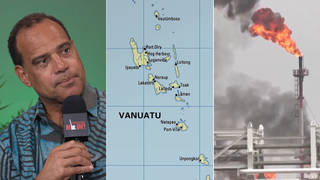
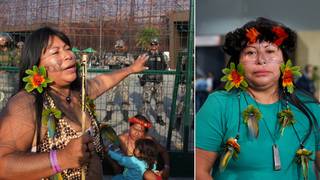
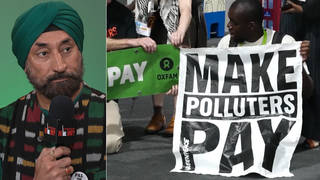
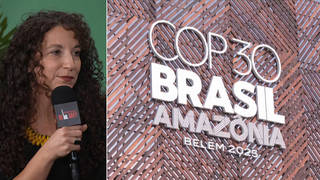





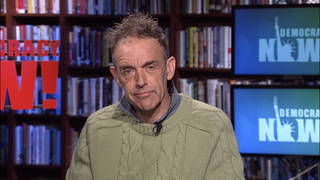
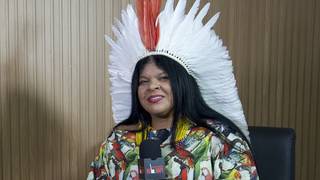
Media Options